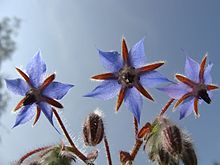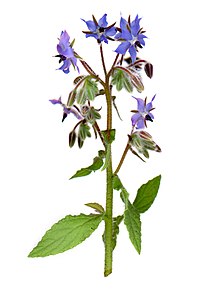Borage
| Borage | |
|---|---|

| |
| Borage flowers | |
| Scientific classification | |
| Kingdom: | Plantae |
| Clade: | Tracheophytes |
| Clade: | Angiosperms |
| Clade: | Eudicots |
| Clade: | Asterids |
| Order: | Boraginales |
| Family: | Boraginaceae |
| Genus: | Borago |
| Species: | B. officinalis
|
| Binomial name | |
| Borago officinalis | |
| Synonyms[1] | |
|
Synonyms
| |
Borage (/ˈbʌrɪdʒ/ [2] or /ˈbɒrɪdʒ/;[3] Borago officinalis), also known as starflower, is an annual herb in the flowering plant family Boraginaceae native to the Mediterranean region. Although the plant contains small amounts of pyrrolizidine alkaloids, some parts are edible and its seeds provide oil.

Description
[edit]
B. officinalis grows to a height of 60–100 centimetres (2–3+1⁄2 feet), and is bristly or hairy all over the stems and leaves; the leaves are alternate, simple, and 5–15 cm (2–6 inches) long.
The flowers are complete, perfect with five narrow, triangular-pointed petals. Flowers are most often blue, although pink flowers are sometimes observed. White-flowered types are also cultivated. The blue flower is genetically dominant over the white flower.[4]
The flowers arise along scorpioid cymes to form large floral displays with multiple flowers blooming simultaneously, suggesting that borage has a high degree of geitonogamy (intraplant pollination).[4]
It has an indeterminate growth habit. In temperate climates such as in the UK, its flowering season is relatively long, from June to September. In milder climates, borage blooms continuously for most of the year. It can be invasive.
Chemistry
[edit]The seeds consist of 26–38% borage seed oil, of which 17–28% is gamma-linolenic acid (GLA, an Omega-6 oil), making borage seed oil the richest known source of GLA.[5]
The oil also contains the fatty acids palmitic acid (10–11%), stearic acid (3.5–4.5%), oleic acid (16–20%), linoleic acid (35–38%), eicosenoic acid (3.5–5.5%), erucic acid (1.5–3.5%), and nervonic acid (1.5%).
Healthy adults typically produce ample GLA from dietary linoleic acid, but borage seed oil is often marketed as a GLA supplement, under the names "starflower oil" or "borage oil".
The leaves contain small amounts (2–10 ppm in the dried herb) of the liver-toxic pyrrolizidine alkaloids (PA) intermedine, lycopsamine, amabiline, and supinine and the nontoxic saturated PA thesinine.[6] PAs are also present in borage seed oil, but may be removed by processing.[7][8][9][10][11][12]
Distribution and habitat
[edit]It is native to the Mediterranean region, and has naturalized in many other locales.[13] It grows satisfactorily in gardens in most of Europe, such as Denmark, France, Germany, the United Kingdom, and Ireland. It is not a perennial, but it remains in the garden from year to year by self-seeding.
Toxicity
[edit]In addition to the liver-toxic pyrrolizidine alkaloids found in the leaves and seed oil, the German Federal Institute for Risk Assessment has advised that honey from borage contains PAs, transferred to the honey through pollen collected at borage plants, and advise that commercial honey production could select for raw honey with limited PA content to prevent contamination.[14]
Uses
[edit]

Traditionally, borage was cultivated for culinary and medicinal uses, although today, commercial cultivation is mainly as an oilseed.
Borage is used as either a fresh vegetable or a dried herb. As a fresh vegetable, borage, with a cucumber-like taste, is often used in salads or as a garnish.[15]
The flower has a sweet, honey-like taste and is often used to decorate desserts and cocktails,[15] sometimes frozen in ice cubes.[16]
Vegetable use of borage is common in Germany, in the Spanish regions of Aragón and Navarre, on the Greek island of Crete, and in the northern Italian region of Liguria.
Although often used in soups, one of the better known German borage recipes is the Frankfurt speciality grüne Soße ("green sauce").
In Liguria, Italy, borage (in Italian, borragine) is commonly used as a filling of the traditional pasta ravioli and pansoti.[17]
It is used to flavour pickled gherkins in Poland[18] and Russia.[19]
The flowers produce copious nectar[20] which is used by honeybees to make a light and delicate honey.[21]

Beverage
[edit]Borage is traditionally used as a garnish in the Pimms Cup cocktail,[15] but is nowadays often replaced by a long sliver of cucumber peel or by mint. It is also one of the key botanicals in Gilpin's Westmorland Extra Dry Gin. The author of Cups and their Customs notes that a sprig or two of borage "communicates a peculiar refreshing flavour" to any cool drink.[22]
In Persian cuisine, borage tea (using the dried purple flowers) is called گل گاوزبان : gol gâvzabân, "cow's-tongue-flower".[23]
Herbal medicine
[edit]Traditionally, Borago officinalis has been used in hyperactive gastrointestinal, respiratory and cardiovascular disorders,[24] such as gastrointestinal (colic, cramps, diarrhea), airways (asthma, bronchitis), cardiovascular, (cardiotonic, antihypertensive and blood purifier), urinary (diuretic and kidney/bladder disorders).[25]
One case of status epilepticus has been reported that was associated with borage oil ingestion.[26]
A methanol extract of borage has shown strong amoebicidal activity in vitro. The 50% inhibitory concentration (LD50) of the extract against Entamoeba histolytica was 33 μg/mLl.[27]
Companion planting
[edit]Borage is used in companion planting.[28] It is said to protect or nurse legumes, spinach, brassicas, and strawberries.[29] It is also said to be a good companion plant to tomatoes because it confuses the mother moths of tomato hornworms or manduca looking for a place to lay their eggs.[30] Claims that it improves tomato growth[31] and makes them taste better[30] remain unsubstantiated.
In culture
[edit]Pliny the Elder and Dioscorides said that borage was the nepenthe (νηπενθές : nēpenthés) mentioned in Homer, which caused forgetfulness when mixed with wine.[32]
King Henry VIII's last wife, Catherine Parr, used borage in a concoction to treat melancholy.[33]
Francis Bacon thought that borage had "an excellent spirit to repress the fuliginous vapour of dusky melancholie".[32]
John Gerard's Herball mentions an old verse concerning the plant: "Ego Borago, Gaudia semper ago (I, Borage, bring always joys)". He asserts:
Those of our time do use the flowers in salads to exhilerate and make the mind glad. There be also many things made of these used everywhere for the comfort of the heart, for the driving away of sorrow and increasing the joy of the mind. The leaves and flowers of Borage put into wine make men and women glad and merry and drive away all sadness, dullness and melancholy, as Dioscorides and Pliny affirm. Syrup made of the flowers of Borage comfort the heart, purge melancholy and quiet the frantic and lunatic person. The leaves eaten raw engender good blood, especially in those that have been lately sick.[32]
See also
[edit]References
[edit]- ^ "Borago officinalis L." Royal Botanic Gardens, Kew. Retrieved 25 July 2024.
- ^ "borage". Oxford English Dictionary (Online ed.). Oxford University Press. (Subscription or participating institution membership required.)
- ^ Le Robert et Collins English-French Dictionary and the American Heritage Dictionary
- ^ a b Montaner, C.; Floris, E.; Alvarez, J. M. (February 2001). "Geitonogamy: a mechanism responsible for high selfing rates in borage (Borago officinalis L.)". Theoretical and Applied Genetics. 102 (2–3): 375–378. doi:10.1007/s001220051656. S2CID 26250534.
- ^ National Non-Food Crops Centre. NNFCC Crop Factsheet: Borage, Retrieved on 16 Feb 2011
- ^ "Borage Wildflower Finder". Wildflowerfinder.org.uk. Retrieved 2013-09-13.
- ^ "Borage". Sloan-Kettering website. Retrieved 2024-09-15.
- ^ Dodson, Craig D.; Stermitz, Frank R. (1986). "Pyrrolizidine alkaloids from borage (Borago officinalis) seeds and flowers". Journal of Natural Products. 49 (4): 727–728. doi:10.1021/np50046a045.
- ^ Parvais, O.; Vander Stricht, B.; Vanhaelen-Fastre, R.; Vanhaelen, M. (1994). "TLC detection of pyrrolizidine alkaloids in oil extracted from the seeds of Borago officinalis". Journal of Planar Chromatography--Modern TLC. 7 (1): 80–82.
- ^ Wretensjoe, Inger; Karlberg, Bo. (2003). "Pyrrolizidine alkaloid content in crude and processed borage oil from different processing stages". Journal of the American Oil Chemists' Society. 80 (10): 963–970. doi:10.1007/s11746-003-0804-z. S2CID 94575246.
- ^ Awang V. C. (1999). Eskinazi D. (ed.). Botanical Medicine: The Information Base for safety assessment of Botanicals.
- ^ Langer T.; Franz Ch. (1997). "Pyrrolizidine alkaloids in commercial samples of borage seed oil products by GC-MS". Scientia Pharmaceutica. 65 (4): 321–328.
- ^ Altervista Flora Italiana, Borragine comune, gurkört, Borago officinalis L. includes photos, drawings, and European distribution map
- ^ "Fragen und Antworten zu Pyrrolizidinalkaloiden in Lebensmitteln" (PDF) (in German). Federal Institute for Risk Assessment. 4 August 2014. Retrieved 12 November 2015.
- ^ a b c "Borage". Encyclopedia of spices. The Epicentre. 2009. Archived from the original on 2013-02-03. Retrieved 2010-12-01.
- ^ "Heston's Cucumber gin and tonic". www.waitrose.com. Retrieved 23 May 2020.
- ^ Logan, Gabi (5 January 2012). "Foodie Guide to Borragine". ITALY Magazine. Retrieved 23 May 2020.
- ^ "Hengstenberg Knax Polish Style Gherkins Choice Grade 720g - Hengstenberg, Germany". ruskiwaydeli.com.au. Retrieved 23 May 2020.
- ^ "Pickled Gherkins - Russian Style". Kühne. 4 December 2015. Retrieved 23 May 2020.
- ^ "Borage: Species information". cotswoldseeds.com. Retrieved 13 June 2020.
- ^ "English Borage Honey". littleoverapiaries.com. Retrieved 13 June 2020.
- ^ Roberts, George Edwin (1863). Cups and their Customs. London: J. Van Voorst. p. 32.
- ^ "CHAI GOL GAVZABAN گل گاوزبان | BREWED BORAGE TEA". 22 October 2015. Retrieved 8 September 2020.
- ^ Gilani A.H., Bashir S., Khan A.-u. "Pharmacological basis for the use of Borago officinalis in gastrointestinal, respiratory and cardiovascular disorders", Journal of Ethnopharmacology 114 (3), pp 393–399, 2007.
- ^ Gilani A.H. "Focused Conference Group: P16 - Natural products: Past and future? Pharmacological use of borago officinalis", Basic and Clinical Pharmacology and Toxicology. Conference: 16th World Congress of Basic and Clinical Pharmacology. WorldPharma 2010 Copenhagen Denmark. Publication: (var. pagings). 107 (pp. 301), 2010. Date of Publication: July 2010.
- ^ Al-Khamees WA, Schwartz MD, Alrashdi S, Algren AD, Morgan BW (2011). "Status Epilepticus Associated with Borage Oil Ingestion". Journal of Medical Toxicology. 7 (2): 154–157. doi:10.1007/s13181-011-0135-9. PMC 3724443. PMID 21387119. After taking 1.5 to 3 g of borage oil daily for a week; level of GLA in blood was high.
- ^ Leos-Rivas C, Verde-Star MJ, Torres LO, Oranday-Cardenas A, Rivas-Morales C, Barron-Gonzalez MP, Morales-Vallarta MR, Cruz-Vega DE (2011). "In vitro amoebicidal activity of borage (Borago officinalis) extract on entamoeba histolytica". Journal of Medicinal Food. 14 (7–8): 866–869. doi:10.1089/jmf.2010.0164. PMID 21476887.
- ^ "Gardening Borage a Companion Plant". Back2theland.com. 2009-05-23. Archived from the original on 2013-03-02. Retrieved 2013-09-13.
- ^ Darlene S. Widirstky. "Herbal Companion Planting in the Vegetable Garden". N8ture. Retrieved 2013-09-13.
- ^ a b Fischer, Fern (21 September 2017). "How to Use Borage". Gardenguides.com. Retrieved 2013-09-13.
- ^ "Companion Planting". Golden Harvest Organics. Archived from the original on 2013-09-24. Retrieved 2013-09-13.
- ^ a b c Grieve, Maud (1971). A Modern Herbal: The Medicinal, Culinary, Cosmetic and Economic Properties, Cultivation and Folk-lore of Herbs, Grasses, Fungi, Shrubs, & Trees with All Their Modern Scientific Uses, Volume 1. Courier Corporation. p. 120. ISBN 9780486227986.
- ^ Susan James. Catherine Parr: Henry VIII's Last Love, 2010
External links
[edit]https://persianmama.com/chai-gol-gavzaban-brewed-borage-tea/
https://www.pinterest.ca/pin/557179785128125722/
- . The American Cyclopædia. 1879.
- "Borage". MissouriBotanicalGarden.org.
